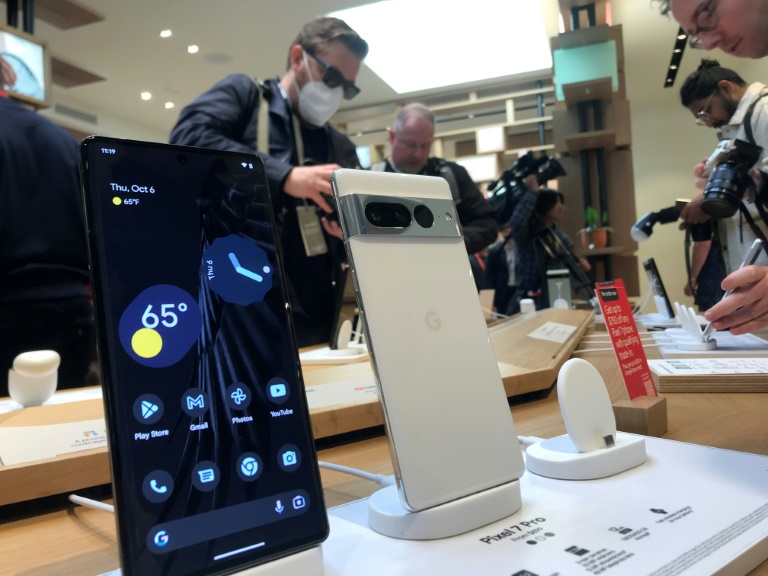Just how much phone radiation can your body tolerate?

Analysts expects smartphone shoppers to be looking for bargains amid inflation and other economic concerns – Copyright AFP ISAAC LAWRENCE
On average people check their mobile phone every 12 minutes, making the fascination with these hand-held computers an inextricable part of our lives. In light of this fact, questions surrounding the potential health impacts of cell phone usage arise more frequently.
One prominent question is “How much radiation can my body tolerate from using a cellphone?”
Mobile phones emit non-ionizing electromagnetic radiation, meaning it does not cause direct damage to cells or DNA. This differs from ionizing radiation such as X-rays or nuclear materials which emit high energy levels that disrupt atomic structure and alter DNA, potentially leading to cancerous growths when uncontrolled exposure occurs.
Mobile phone radiation emissions are measured using “specific absorption rate”, an international standard established by regulatory bodies. In the U.S., for instance, regulatory bodies set an allowable maximum SAR limit at 1.6 watts per kilogram over 1 g of tissue for head and torso exposure.
In contrast, in Europe, the maximum limit is 2 watts averaged over 10 grams.
Based on these levels, assumptions about mobile phone radiation exposure vary. Some researchers think these levels pose a significant health risks while others do not believe this to be the case.
According to the International Agency for Research on Cancer (IARC), mobile phone radiation falls into Group 2B for possible carcinogenicity due to studies linking heavy users and possible exposure, but with no conclusive proof showing its cause.
The World Health Organisation points out:
“Epidemiological research examining potential long-term risks from radiofrequency exposure has mostly looked for an association between brain tumours and mobile phone use. However, because many cancers are not detectable until many years after the interactions that led to the tumour, and since mobile phones were not widely used until the early 1990s, epidemiological studies at present can only assess those cancers that become evident within shorter time periods.”
Therefore, a degree of uncertainty exists.
As an indicator of government concern, French regulators recently ordered Apple to stop selling the iPhone 12 due to emissions exceeding European Union exposure standards. Apple denied these findings and maintained their device is compliant with regulations.
The iPhone 12 released in late 2020 failed one of two electromagnetic wave tests designed to assess their capacity to be absorbed by our bodies. The National Frequency Agency tested 141 cell phones and found that when held or carried in pockets by hand or pocket, an iPhone 12 absorbs 5.74 watts per kilogram – higher than the EU standard of 4 watts per kilogram.
The agency told Apple to carry out all available means to immediately correct this malfunction for phones already in use. If nothing works, the phone company must recall the model, already sold.
Josh Gordon, a technology expert at Geonode has told Digital Journal: “The data on mobile phone radiation and health risks remain inconclusive. Out of hundreds of studies conducted over the past few decades, some suggest a possible link between long-term mobile usage and health problems such as brain tumours or infertility. Yet many other studies contradict these findings. The problem is that this topic is highly complex, and isolating the influence of mobile phone radiation on human health is exceedingly difficult. Often, studies contradict each other, and seeing a clear pattern is challenging.”
Gordon says that it is crucial to understand that:
- Exposure to mobile phone radiation depends heavily on how and where the device is used.
- Other lifestyle, genetic and environmental factors also impact these potential health conditions.
- Mobile phones have only been widely utilized for a handful of decades, making it difficult to study their long-term impacts accurately.
Although the risks associated with phone radiation remain poorly understood and are thought to be minimal, limiting unnecessary exposure might prove important to protect health. Gordon recommends limiting mobile phone conversations or use a hands-free device or speakerphone. The further away your phone is from your body, the less radiation is emitted into the environment. Gordon also advises not storing your phone on your body.
Just how much phone radiation can your body tolerate?
#phone #radiation #body #tolerate





